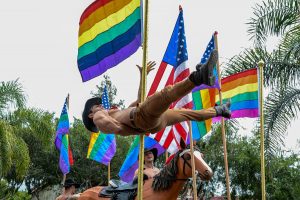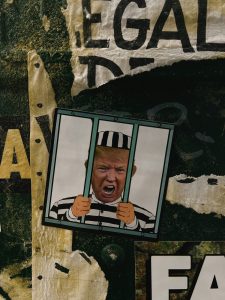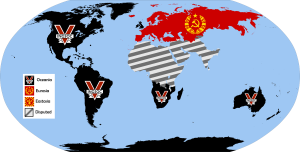One thing is clear: Christmas traditions differ in every country in which they are celebrated.
The pre-Christian Germanic peoples centered their winter celebration, Yule (which is still mentioned in the same breath as Christmas) around the god of Odin. Odin was a white-bearded gift-giver from the north, who rode a grey horse and often delivered runes as presents (much like the chocolate letters that Sinterklaas brings). Odin had black ravens, Huginn and Muninn, who gathered information for Odin, serving a function similar as Sinterklaas’ Zwarte Piet. Odin is father of the Norse thunder god, Thor; later on Santa Claus will have reindeer named Donner (thunder) and Blitzen (lightning).
Meanwhile back in Christendom, Saint Nicholas (270 – 343), bishop of Myra, was an actual historical personage, who became known as the patron saint of children. Because his remains were interred in the then-Spanish city of Bari, it became tradition that he came from Spain, and was assisted by his Moorish pageboy, Zwarte Piet. In the middle ages, students began to celebrate Saint Nicholas festivals in schools and later in the towns. During the Dutch Golden Age, the Calvinist regents banned such celebrations, just as the Puritans in England also banned Christmas on the grounds that it was unbiblical, even pagan.
Dutch settlers brought the Sinterklaas tradition with them to New York in the seventeenth century, where it slowly mixed with the British tradition of “Father Christmas.” In the U.S., the American Santa Claus evolved from the Dutch Sinterklaas, itself a contraction of Sint Nicolaas (others say it came from the German, Sankt Niklaus). Washington Irving (best known the author of “Rip van Winkel”) Americanized Sinterklaas into “Santa Claus” in his History of New York (1809), a lampoon of Dutch culture in New York. In Irving’s work, Santa Claus departs from the bishop Saint Nicholas; he is depicted as a fat Dutch sailor in a green winter coat and smoking a pipe. In a dream sequence he drives a flying wagon.
In the landmark poem “A Visit from St. Nicholas” (1822) (“’Twas the Night Before Christmas” is the famous first line) Saint Nicholas leads a reindeer-led flying sled, and the children hang their stockings by the chimney. He is still called Saint Nicholas (not Santa Claus), but many other elements of the modern American Santa Claus are present. The “jolly old elf” has lost all traces of the Bishop Saint Nicholas.
Some 19th century Americans, in an attempt to Christianize the arguably pagan Santa Claus, also called Santa “Kris Kringle” (German for Christ child). To this day Christmas celebrations in the U.S. include both the purely religious celebrations of the birth of Christ as well as the less Christian Santa Claus stories.
Political cartoonist Thomas Nast in Harper’s Weekly (1863) drew Santa Claus dressed in a fur coat and smoking a clay pipe. Nast’s Santa Claus was decidedly pro-Union in the American Civil War (1861-65), so was used for political purposes.
Some of the final touches on the American image of Santa Claus were created by the Coca-Cola company, which in 1931 created a series of advertisements in which Santa either gives Coke as a present, or it is left for him as a present (a more sugary treat than the carrot left for Sinterklaas’ horse).
After World War II, the American images of Santa Claus were exported around the world (along with Coca-Cola and other icons of American culture). Saint Nicholas still retains his traditional bishop’s appearance in Continental Europe.
Finally, here is an overview of differences between the Dutch Sinterklaas and the American Santa Claus.
Sinterklaas vs Santa Claus – Overview of Differences
| Characteristic | Sinterklaas | Santa Claus |
| Recognized in … | Netherlands, Belgium, Germany, Austria | United States; known the world over |
| Year-round Residence | Lives in Spain | Lives at the North Pole |
| Marital Status / Family | Bachelor/Celibate Bishop | Married to Mrs. Claus (No kids) |
| Date for giving presents | Gives gifts on 5 December | Gives gifts on 25 December (or night before) |
| Helpers | Is helped by (Black) Petes | Is helped by elves |
| Transportation | Rides a white horse (Amerigo) and on a steamboat | Rides a sleigh pulled by flying reindeer (Dasher, Dancer, etc., and later Rudolph) |
| Location of gifts | Puts gifts in shoes | Puts gifts in stockings or under the Christmas tree |
| Food children leave | Carrot for the horse | Cookies and Milk for Santa. Optional carrot for the reindeer.
Later, a Coca-Cola. |
| Birthday | 6 December is his birthday. | 25 December (Jesus’ birthday in popular tradition) |
| Suit | Bishop’s garb (with cape) | Red suit, white-fringe, black belt |
| Hat | Wears a bishop’s mitre | Wears a red and white winter cap with a white pom-pom on the end. |
| Carries | Shepherd’s crosier | Big sack of toys |
| Punishments | Punishments for naughty range from light (no candy) to severe (kidnapping to Spain for flogging by Black Peters) | Leaves a lump of coal as gift;
No corporal punishment |
| Is a Writer? | Writes charming poems that point out the foibles of the recipient | Not much of a writer |
| Intelligence Network | Relies on the Petes to gather information | Essentially omniscient (“He sees you when you’re sleeping; he knows when you’re awake.”) |
| Experiences “Senior Moments”? | Sometimes charmingly senile, relying on the Petes to remind him of things | Sharp as a tack. |
| Awareness of each other | Acknowledges that Santa exists. | Never acknowledges the existence of Sinterklaas |
Sources
The True Story Of Santa Claus
America and the Creation of Santa Claus: A Guide
Saint Nicholas and the Origin of Santa Claus






Be First to Comment